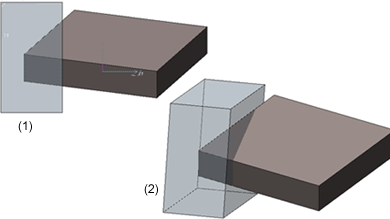
3-D Standard > Process > MovePts 
Use the Points function group in the 3-D Standard tab to model 3-D parts by moving individual points. The following functions are available:

|
Move points in rectangle, two 3-D points You move all points lying within an arbitrary rectangle by specifying a vector. First define a rectangle by specifying the bottom left and top right corner. Up to 10 of such selection rectangles are possible. Right-click to end the rectangle definition. If the selected rectangles contain points that do not belong to the active part, HiCAD asks whether you want only the points belonging to the active part or all points of the drawing lying within the rectangles to be moved. You define the displacement vector by specifying two 3-D points. |
Click  to open a menu with the following functions: to open a menu with the following functions: |
|

|
Move points, in edge direction As above, the displacement vector is however defined via the identification of an edge in the drawing. The direction of the displacement vector is determined by the position of the identification point. If the identification point lies to the left of the midpoint of the edge, the vector has a positive direction; if not, it has a negative direction. |

|
Move points, 2-D via 2 points As above, the displacement vector is however defined via the specification of two 2-D points. |

|
2 lines (2-D) The displacement vector is defined via the identification of two parallel 2-D graphical elements. A perpendicular (in 2-D) is dropped from the first line to the middle of the second line |

|
2 points + Length The displacement vector is defined via:
If you enter the value 0 for vector length, the displacement can also be performed dynamically with the cursor. |

|
Perpendicular Point -> Edge The displacement vector is defined via a perpendicular from a point to an edge |

|
Perpendicular Point -> Surface The displacement vector is defined via the specification of the start point and the identification of a surface. The end point of the vector is determined by a perpendicular from the start point to the surface or its enlargement. |

|
Vertical to surface The displacement vector lies on a surface normal. You can define the surface via:
The start of the vector lies on the edge end that is closer to the 1st identification point. The vector stands perpendicular on the selected surface. |

|
In dimension direction The displacement vector lies on the dimension line. |

|
Last vector Uses the displacement vector that was defined last. |

|
Last vector back Inverts the displacement vector that was defined last. |
![]() Please note:
Please note:

(1) Rectangle, (2) Rotated view with search cuboid
In addition to the functions described here, you can also insert or delete isolated points and point designations. For example, you can use two isolated points for the definition of rotation axes. You can access the appropriate functions via 3-D Standard > Tools > New point.
Related Topics
Model and Process Parts (3-D) • Edge Functions (3-D) • Surface Functions (3-D)
Version 1702 - HiCAD 3-D | Date: 9/2012 | © Copyright 2012, ISD Software und Systeme GmbH